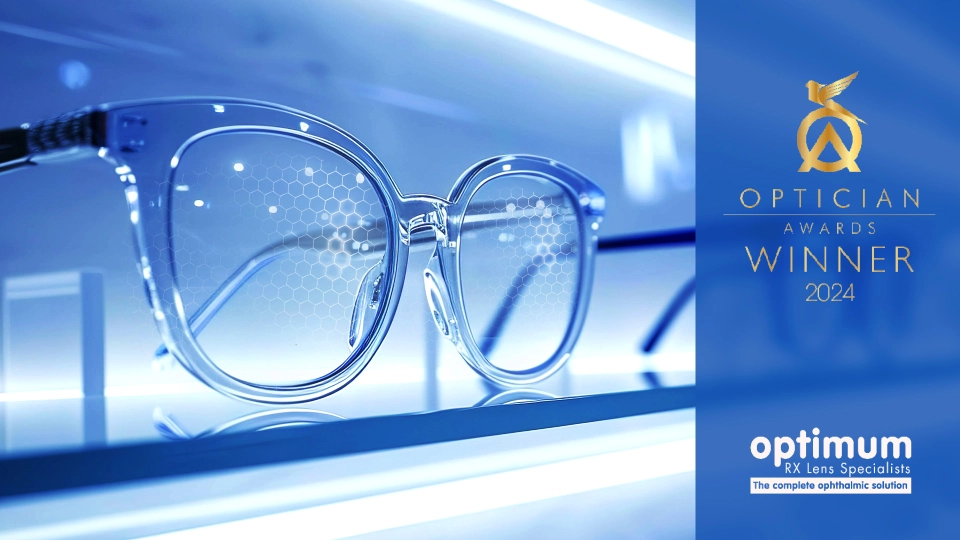
What Are Progressive Lenses & How Do They Work?
Progressive lenses have revolutionized how patients experience clear and comfortable vision at all distances. Discover the various types of progressive lenses, their pros and cons, and how and when to recommend them to patients.
- What are progressive lenses?
- Who uses progressive lenses?
- How do progressive lenses work?
- Addressing peripheral blur
- Progressives vs single vision lenses
- Progressives vs bifocals and trifocals
- Progressive lens types
- Type 1: Conventional progressive lenses
- Type 2: Free-form entry-level progressive lenses
- Type 3: Freeform mid-range progressive lenses
- Type 4: Free-form advanced progressive lenses
- Type 5: Dual-surface progressive lenses
- Adding value to progressive lens groups
- Photochromic lenses
- Premium Camber photochromic
- Pros and cons of progressive lenses
- Pros of progressive lenses
- Cons of progressive lenses
- Choosing the right lens type

What Are Progressive Lenses & How Do They Work?
Progressive lenses have revolutionized how patients experience clear and comfortable vision at all distances. Discover the various types of progressive lenses, their pros and cons, and how and when to recommend them to patients.
More and more people choose progressive lenses each day, opting for the benefit and comfort this lens technology provides over single-vision or traditional options like bifocals. With the market growing by over 4% each year, the advancement of progressive lens technology brings comfort and convenience to people who wish to see clearly at all distances.
Understanding progressive lenses and how they work can help ECPs recommend the best solutions for patients and labs to decide which lens designs to add to their portfolio.
What are progressive lenses?
Progressive lenses are multifocal lenses with seamless power transitions. Instead of a noticeable line between two or three prescription powers in the lens, progressive lenses have a smooth and continuous gradient, allowing them to incorporate many prescription zones. As the design eliminates abrupt changes between powers, many people find these lenses comfortable and more adaptable to everyday life as they can see distance, intermediate, and near vision through one pair of glasses.
Progressive lenses have traditionally been available in one of two categories, though most new ones are hybrids, blending elements from each.
- Hard design: Hard progressive lens designs feature a wide-distance zone that narrows in the intermediate before widening again in the near zone. Individuals who prioritize distance vision often prefer these designs.
- Soft design: Soft progressive lens designs offer a narrower distance and near areas, with a larger intermediate vision zone ideal for computer work or arm's length activities. These lenses are well-suited for first-time progressive wearers or those prioritizing intermediate distances.
The type of design chosen can depend on the specific needs of the wearer, which leads to who is using progressives.
Who uses progressive lenses?
These lenses address various visual needs so that many people can benefit from a progressive design. Broadly, the following typically receive the best benefit in visual correction from these lenses:
- Those needing multifocal correction
- Presbyopes
- Youths with accommodative issues
- Digitally connected wearers
- Day and night drivers and drivers with myopia
- Occupational professionals with specific vision needs, like pilots or electricians
Naturally, this list is not inclusive, and progressive lenses suit many customizable needs.
How do progressive lenses work?

Progressive lenses are constructed with a unique gradient surface that incorporates multiple prescription powers along the vertical meridian. A wearer needs to learn to shift their gaze through different sections of the lens in order to focus on different distance zones. As the eye gaze moves from the top of the lens to the bottom, the optical power increases. This means a wearer can see distances best through the top of the lens, intermediate distances through the middle, and close-up ranges through the base of the lens.
Addressing peripheral blur
One inherent characteristic of progressive lenses is a degree of peripheral blur. This occurs because the lens power changes gradually from top to bottom, creating areas of distortion, particularly in the periphery. Wearers may experience a "swim" or swaying sensation as their eyes move away from the center of the lens.
The extent and location of peripheral blur can vary depending on several factors, including:
- Lens Design: Different progressive lens designs prioritize clear vision in specific zones. Some designs minimize peripheral blur in the distance zone for drivers, while others focus on reducing blur in the near zone for reading or computer work.
- Prescription Strength: Stronger prescriptions often result in wider areas of peripheral blur due to the greater variation in lens power.
- Frame Size: Smaller frames can limit the available space for the different vision zones, potentially increasing peripheral blur.
To address these challenges, manufacturers have developed various strategies:
- Advanced Calculation Algorithms: Sophisticated algorithms are used to optimize the lens surface, minimizing distortion and widening the usable areas of clear vision. Such calculations can result in regulating the mean power throughout the lens to reduce power errors. Learn more about Steady Methodology →
- Using Accommodative Space: Modeling the wearer’s accommodative object space helps incorporate their natural ability to minimize oblique aberrations. Learn more about Digital Ray-Path 2 technology →
- Freeform Technology: Freeform manufacturing allows for countless lens configurations tailored to the individual's prescription, frame choice, and visual habits, further optimizing the visual experience and minimizing peripheral blur.
By carefully considering these factors, eye care professionals can select progressive lenses that strike the right balance between peripheral blur and clear vision in the most important zones for each individual wearer.
Key Takeaway: It's important for patients to understand that some degree of peripheral blur is normal with progressive lenses. While it may take some time to adjust, most wearers find that the benefits of clear, multifocal vision far outweigh this minor inconvenience.
Learn more: Troubleshooting Progressive Lenses
Progressives vs single vision lenses

Single-vision lenses excel at providing clarity at one distance, whereas progressives provide clarity at multiple distances. A single-vision option will suffice if a patient has only one visual defect or needs corrections at one task, like reading.
Learn more: Single Vision vs. Progressive Lenses: Understanding the Difference
Progressives vs bifocals and trifocals

Bifocals have distinct zones for distance and near, and trifocals have clearly defined areas for fixed near, intermediate, and distance viewing. Some wearers prefer having visible lines separating the viewing zones. In particular, older wearers may want to avoid going through the adaptation period for progressives and prefer sticking with their traditional options.
A short corridor option is advisable for smoother adaptation for existing bifocal and trifocal wearers who wish to convert to progressives.
Learn more: Endless Possibilities with Endless Bifocal
Progressive lens types
Progressive lenses are organized into different groups, reflecting the lens design complexity, the level of customization, and the advanced technologies employed in the manufacturing process. Many lens manufacturers will give the tiers a custom-branded term, but the general naming patterns and changes in complexity are applicable across all portfolios.
Type 1: Conventional progressive lenses
These basic progressive lenses offer an affordable option with a conventional lens design. To make them more cost-friendly, they are not free-form nor include any advanced customization. Instead, they are molded with a standard design to address the majority of prescriptions. They may have a narrow field of view for some wearers and a higher amount of visual distortion in the peripheral zone.
Type 2: Free-form entry-level progressive lenses
These progressive lenses utilize freeform design and advanced digital manufacturing processes to enhance visual clarity and comfort compared to conventional lenses. However, these lenses do not include personalization for individual wearers. They are designed with standard parameters, making them more accessible while providing better performance than conventional progressive lenses.
Type 3: Freeform mid-range progressive lenses
Mid-range free-form progressive lenses offer a step up in customization, incorporating basic aberration calculations or default personalization parameters. These lenses provide a balance between affordability and improved visual performance. The customization process helps reduce visual distortions and improve the wearer’s overall experience, offering wider fields of view and better adaptation compared to entry-level options. The specific customizations incorporated into advanced designs can reduce eye strain, though at a higher price point when compared to progressive lenses with less customization.
Type 4: Free-form advanced progressive lenses
Advanced free-form progressive lenses are fully personalized, taking into account a wide range of individual measurements and wearer-specific data. This high level of customization results in superior visual clarity, minimal distortion, and maximum comfort. These lenses are tailored to the unique visual needs and lifestyle of the wearer, offering the best possible performance and ease of adaptation. Accordingly, these lens designs start at a higher price point for the patient.
Type 5: Dual-surface progressive lenses
Dual-surface progressive lenses, such as Camber lenses, represent the pinnacle of progressive lens technology. These lenses combine complex free-form designs on both the front and back surfaces, offering unparalleled customization and visual performance. The dual-surface approach allows for a more precise correction of visual aberrations, providing exceptionally wide fields of view and natural vision at all distances. This advanced technology significantly reduces visual distortions and enhances the overall visual experience, making them ideal for wearers seeking the highest quality lenses available.
Discover Camber progressive lenses →
Learn more: 8 Types of Progressive Lenses
Adding value to progressive lens groups
Though progressive lens types can be categorized into the groups above, it is important to note these designs can offer more benefits as well. Some specific value-added options create nuanced styles and groups for progressive lenses that are still worth considering. For example, these additional subtypes could be:
Photochromic lenses
Photochromic progressive lenses adapt to changing light conditions by darkening in sunlight and clearing up indoors. These lenses provide the convenience of varifocal vision correction along with protection from UV rays and glare. Photochromic lenses are ideal for wearers who spend long hours in the sun while still needing to focus at multiple distances.
Discover photochromic progressive lenses →
Learn more: Protect Your Patient’s Vision With Photochromic Lenses
Premium Camber photochromic
Photochromics can offer enhanced performance when coupled with Camber technology such as that offered in the Neochromes product family. These lenses provide enhanced protection from UV rays while also providing more comfortable and consistent vision for progressive lens wearers.
Discover Neochromes with Camber Technology →
Pros and cons of progressive lenses
Eye care professionals must comprehensively understand the advantages and potential drawbacks of graduated progressive lenses to prescribe them to a patient accurately.
Pros of progressive lenses
1. Clear vision at all distances
The multifocal ability of progressive lenses lets a wearer focus at near, intermediate, and far distances. This flexibility allows wearers to have one pair of glasses throughout their day and seamlessly transition between tasks, such as reading a book, driving a vehicle, or viewing a building in the distance.
2. Aesthetics and design
The elimination of the distinct line between prescription powers (like that found in bifocals and trifocals) removes the image jump phenomenon associated with those designs. The seamless transition creates a more modern look, which many wearers find aesthetically pleasing.
3. Comfort and convenience
In progressive lenses, the gradual power progression provides a seamless transition between vision zones, enabling more natural postures and a relaxed visual experience, improving overall comfort.
Cons of progressive lenses
1. Adaption period
A wearer must train their eye to gaze through different areas of the lens to clearly see different focal zones. Wearers must be advised to expect a period of adaptation to learn how to use their lenses for the best results. With more advanced designs and consideration of lifestyle needs, this adaptation period can be reduced dramatically
2. Reduced peripheral vision
While progressive lenses provide optimal visual clarity in the central vision zones, there can be some visual aberrations in the peripheral zones. A wearer might experience reduced clear vision or distortion towards the edges of these lenses. This limitation is inherent to the lens design and can be more pronounced in certain lens types or prescriptions. This effect can be reduced with careful lens selection.
3. Higher initial cost
Due to their advanced design and manufacturing processes, progressive lenses generally start at a higher cost than other lens designs, such as single-vision or bifocals. Ultimately, these lenses can be cheaper than buying multiple glasses for different purposes. While an increased initial cost is to be expected with progressives, the benefits for the wearer are vast.
Choosing the right lens type
When selecting the most appropriate lens type, several factors should be taken into consideration, including:
- Visual needs and lifestyle: The individual's specific visual requirements, such as the amount of time spent on near, intermediate, or distance tasks, as well as their overall lifestyle and activities, can affect the best lens for them.
- Prescription strength: Stronger prescriptions may require more advanced lens designs or customizations to minimize visual distortions or other limitations.
- Frame size and fit: The size and fit of the eyeglass frame can influence the lens design and performance, particularly for progressive lenses.
- Personal preferences: Some individuals may have preferences or concerns related to aesthetics, adaptation periods, or specific visual requirements.
Progressive lenses have revolutionized how patients experience clear and comfortable vision at all distances. By seamlessly integrating multiple vision zones into a single graduated lens, wearers have a versatile and modern solution for their visual needs. From the gradual power progression and wide fields of view, progressive lenses have become a preferred choice for many eyeglass wearers. Understanding how they work, the technology behind them, and how customizations can change their functionality goes a long way to assisting patient adaption and comfort, resulting in fewer lab redos.
To learn more about what different progressive lens designs can do for your lab or eye care practice, please contact us at IOT Lenses; our team will love to answer your questions.






